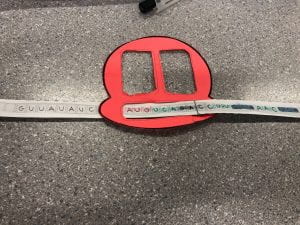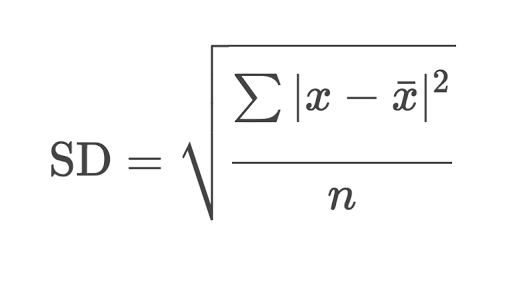Protein Synthesis Biology 12
In my Anatomy and physiology 12 class, we conducted a lab where we simulated the steps of Protein Synthesis using a paper model.
1. Describe the process of transcription: unwinding, complementary base pairing, separating
The first step of protein synthesis is transcription, this is when the RNA translates the messages from the DNA sequence using ribosomes. Here are the steps of transcription:
A gene (section of DNA) unwinds using the DNA enzyme helicase. Once the two DNA strands have separated, this will allow for the messenger RNA (mRNA) to copy the message from DNA along the nonsense strand, RNA polymerase will connect complementary RNA bases to the DNA by hydrogen bonding. Once the copying has been completed, separation will occur by the mRNA releases the strand of DNA and exists the nucleus via nuclear pores. Protein synthesis continues.
Here is the unzipping/unwinding process
This shows how the mRNA strand was able to transcribe the DNA message through complementary base pairing. Now it has the corresponding bases to proceed to the next step.
Now that the codons are apparent, there is a separation between each of the bases. The mRNA is now able to release the DNA strand which will exit the nucleus.
2. How did today’s activity do a good job of modelling the process of transcription? In what ways was our model inaccurate?
This model gave us the opportunity to greater our understanding of what this process looks like. We were able to see what the process looks like as a whole system. Although it was not accurately sized, there were a couple of other missing components specifically the actual double helix DNA shape in the beginning. There was also no factor of the bases facing outwards on the RNA strand. We were also not able to see how many other enzymes worked in the process of transcription. Another aspect that we did not get to observe would be the representation of the bonding between the backbones and the bases.
3. Describe the process of translation: initiation, elongation, and termination.
There are three stages for translation, initiation, elongation, and termination. when the mRNA arrives at the ribosome the two separated pieces revert together. With the help of rRNA, the ribosome can hold on to the mRNA and begin reading it. Each of the codons is now being read until it reaches the correct start codon (AUG). Now the amino acids can be ordered. The AUG codon is read by the P-site. As this codon is read, a tRNA carrying the eligible amino acid is brought to the current location. The foot of the tRNA has three bases it is the complementary bases of the mRNA, these are known as the anti-codon. This specific sequence allows the tRNA to attach to only 1 mRNA codon. After initiation is over, elongation begins. Now as the strand of mRNA continues to be read, for every codon a tRNA brings over the correct amino acid, beginning the elongation stage. The tRNA initially is placed at the A-site. The amino acid from the P-site and joins the amino acid on the tRNA at the A-site. This changes the shape of the tRNA, completely stopping it from doing its tasks so then it will leave. The ribosome will ensure that the P site is not vacant, and this is when the will transfer to the next codon as well as the growing tRNA amino acid sequence chain. This process of reading each codon, summoning a tRNA, and extending the amino acid chain repeats. From now on, this process will not stop until it encounters a stop codon. This is the termination part of the cycle. There will be no tRNA for a stop codon, so when nothing arrives at the A-site, everything simply falls apart from each other. The ribosome is going to revert to two pieces, the mRNA strand is let go, and the tRNA can release the polypeptide, this is the brand new protein.
This is when the ribosome pieces are assembled and holding on to the mRNA. It’s beginning to read the codons, it has now found the start codon.
The start codon was read in the P-Site, requesting a tRNA with an amino acid attached.
This is the start process of Elongation. The following codon is read, calling over a tRNA with a corresponding anti-codon and amino acid.
The tRNA does not have an amino acid, the shape has changed and it can no longer hold on to its spot in the P-site, and so it leaves.
The ribosome dissaproves of the P-site being empty, so it reaches over for the tRNA and begins reading the next codon.
This process will now repeat until it reaches a stop codon. Nothing will arrive at the A-site as there is no matching tRNA. This begins the process of termination.
This is when everything will release and fall apart from the ribosome. The tRNA releases the polypeptide chain of amino acids which makes a new protein.
4. How did today’s activity do a good job of modelling the process of translation? In what ways was our model inaccurate?
Similar to transcription, this activity brought everything available for visualization. We were able to see the stages and steps of this process. However, there are a couple of things that were missing from this model. For example, we did not get the opportunity to see the joining of the two ribosomes. Another factor that could be deemed inaccurate would be the shape change in the tRNA after the amino acid transfers over. However, we were able to see the basic steps of this cycle and highlight the important stages of Protein Synthesis
artist digital portfolio
In my art class, we reflected on the assignments that we have done this semester.
Math 11 Applications of statistics
In this post, I am sharing some information that I learned in my Math 11 foundation class surrounding the applications of statistics.
In many given problems it is important to find the mean, median, range, and mode.
To find the mean: you take add of the numbers in the data, divide this by how many numbers there are to then find the average. the mean is the average between all of the numbers in that set of data.
To find the mode: You look at the data and find the number that appears the most.
To find the median: You put all the numbers in the grouping from smallest to largest and you find the number that has the middle value. the number needs to be directly center if there is an odd number of data or average the two in the middle if it is an even.
To find the range: take the largest number in the set and subtract the smallest.
Standard deviation:
To find the standard deviation, first find the mean of the set, (instructions above) for each number in the set subtract the mean and then square it. Take the new numbers to use the steps above to find the mean, finally, square root this number and you will have your standard deviation product.

Critical Thinking assessment
In my Rap class, we completed a reflection based on core competencies.
 Loading...
Loading...
 Loading...
Loading...
 Loading...
Loading...
Thoughts on Data Analysis 2018
what role do statistics have on our society?
In my opinion, statistics play a major role in our society, it gives people more of a choice. People don’t always get choice and when they do I think that they should use it to their advantage. People can get very angry when they don’t feel heard and that can result in many consequences. In our society people nowadays spend most of their time on technology and don’t often give things a second thought. with statistics, people have the option to make decisions for themselves and the community. Although, there are some negative things about statistics, people who don’t vote or make an impact often make the survey or statistics inaccurate if the voting doesn’t have proper standards.
What have I learned from the article about the importance of statistics in our society?
statistics play a huge role because they provide solid information for the person receiving them, they can give solid information for the person’s research. Data provides the opportunity to back up information for example evidence. Without proper data, people are forced to make decisions and choices by making educated guesses based on the case. Which might result in consequences that affect other people in negative ways.
There are also some problems with statistics;
This may not be the questioner’s fault but sometimes the vote and or poll can be represented in an incorrect matter. People can make mistakes and errors in their question causing the results to be inaccurate.
Here are some factor’s
Bias – does the question show a preference for a specific product?
Use of Language – Is the question presented in such a way that people understand what is being
asked?
Ethics – Does the question refer to inappropriate behaviour? Ethics involves judgement of
right or wrong. For example, cheating on a test is considered wrong.
Cost – Does the cost of the study outweigh the benefits?
Time and Timing – Does the time the data was collected influence the results? Is the timing of the
survey appropriate?
Privacy – Do people have the right to refuse to answer? Are the responses kept confidential?
Cultural Sensitivity – Might the question offend people from different cultural groups?
86% of statistics are made up on the spot, you know – the remaining 24% is mathematically flawed.
Midsummer Nights weather report-Claire Bajaj
In my English class we read the play Midsummer’s dream, we were given the assignment to write a paragraph of a magical weather report.
Climate change, everyday climate change effects millions of people Around the world. Something as simple as ice bergs melting because of global warming has a large effect on today’s society. Natural habitats are damaged, and animals are having a harder fight to survive each day. Today’s current dilemma is a ginormous spread of wild fires in the northers part of British Columbia, Canada. The large spread of smoke and flames is damaging forests, people’s homes and plenty more. The increase Global warming is making the frequency of theses wild fires 80% more likely. People believe that the cause of this dilemma is from nature the conflict between the gods above Oberon and Titania. Oberon and Titania are set to be married in 4 days but it stirs up a conflict when Oberon claims Titania is in love with Theseus, the Duke of Athens. Titania also accuses that Oberon is Hippolyta’s lover. The two gods are also believed that they are having an argument about who gets to take care of a little boy, this argument is causing a big portion of the conflict. In, order to fix the weather problem, they need to resolve their conflict, so their natural forces can work together as they should. The only way they can resolve their argument is if they learn to trust each other and come to a common agreement.
-Claire Bajaj
The Veldt creative ending-claire bajaj
(this is a project I completed in English for the short story The Veldt.) the veldt creative ending-1kuoqce











